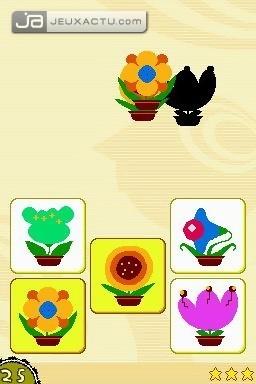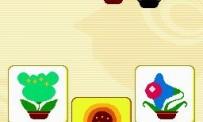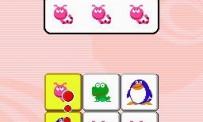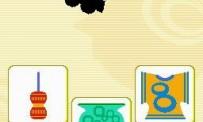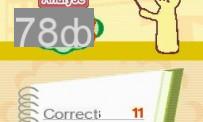 If Japan is experiencing a new video game phenomenon with Brain Training, More DS Brain Training, DS Brain Training English on DS and several titles on PSP, the lengthy titles of which I will spare you, the European triumph of these puzzle games is in its infancy. . Building on the success of Dr. Kawashima's Brain Training Program: How old is your brain? which makes it possible to evaluate its speed of reflection, Nintendo continues without dragging with Cérébrale Académie also known under the names Big Brain Academy in the USA and Yawaraka Atama Juku in Japan. No question therefore of abandoning his cerebral cortex even during the summer holidays. But rather than offering a title with a surgically sober realization and boring mini-games which have just come out of exams, Nintendo is changing the concept of its tests to change the weight of your brain with a much more playful approach. From now on, when you are called heavy, it will be a compliment!
If Japan is experiencing a new video game phenomenon with Brain Training, More DS Brain Training, DS Brain Training English on DS and several titles on PSP, the lengthy titles of which I will spare you, the European triumph of these puzzle games is in its infancy. . Building on the success of Dr. Kawashima's Brain Training Program: How old is your brain? which makes it possible to evaluate its speed of reflection, Nintendo continues without dragging with Cérébrale Académie also known under the names Big Brain Academy in the USA and Yawaraka Atama Juku in Japan. No question therefore of abandoning his cerebral cortex even during the summer holidays. But rather than offering a title with a surgically sober realization and boring mini-games which have just come out of exams, Nintendo is changing the concept of its tests to change the weight of your brain with a much more playful approach. From now on, when you are called heavy, it will be a compliment!
All well thought out...
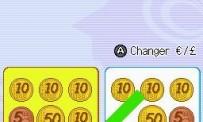 The training offered in Cérébrale Académie is divided into 5 categories involving logic, memorization, analysis, mental calculation and identification. And for each group, 3 events and 3 levels of difficulty (Easy, Normal and Hard) await you. But let's start with a first group: logic. First, you need to distinguish which object or animal is the heaviest on a scale. Obviously, the exercise is not the most complicated since it suffices to notice which icon tips the scales. But the task becomes more complicated when two or even three scales appear and when the items offered are different from one scale to another. Suffice to say that compared to Brain Training, each test is different from the previous one and that the habits of play do not govern the result but that it is indeed your spirit of deduction which does the job. It's the same with the test where you have to draw lines between each column to match the animals, or the one that requires you to move a dog towards its bone on a checkerboard respecting the directions displayed on the upper screen. . A good point therefore that Cérébrale Académie scores against its direct "competitor".
The training offered in Cérébrale Académie is divided into 5 categories involving logic, memorization, analysis, mental calculation and identification. And for each group, 3 events and 3 levels of difficulty (Easy, Normal and Hard) await you. But let's start with a first group: logic. First, you need to distinguish which object or animal is the heaviest on a scale. Obviously, the exercise is not the most complicated since it suffices to notice which icon tips the scales. But the task becomes more complicated when two or even three scales appear and when the items offered are different from one scale to another. Suffice to say that compared to Brain Training, each test is different from the previous one and that the habits of play do not govern the result but that it is indeed your spirit of deduction which does the job. It's the same with the test where you have to draw lines between each column to match the animals, or the one that requires you to move a dog towards its bone on a checkerboard respecting the directions displayed on the upper screen. . A good point therefore that Cérébrale Académie scores against its direct "competitor".
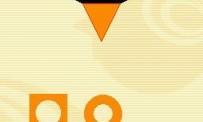 For memory exercises, you must watch the top screen carefully and repeat game sequences using your stylus on the touch screen. The tests can be both sound and visual and you will then have to enter the numbers revealed, reveal the hidden icon or sound the noises heard beforehand in the same order. Scrupulously following what you are ordered is also part of the Animal Analysis Mode where you must trace vertically, horizontally or diagonally the same combination of animals displayed above. Conversely, in this same Analysis Mode, a test will ask you to count the cubes stacked on top of each other without forgetting those hidden in the background. The level of difficulty will increase according to your correct answers, which will influence the size of the boxes and their number on the screen. The last analysis challenge could not be simpler since it suffices to reproduce the image by drawing a short line from one point to another. Of course, here too, your success will force the game to rotate the illustrations to shake your brains out.
For memory exercises, you must watch the top screen carefully and repeat game sequences using your stylus on the touch screen. The tests can be both sound and visual and you will then have to enter the numbers revealed, reveal the hidden icon or sound the noises heard beforehand in the same order. Scrupulously following what you are ordered is also part of the Animal Analysis Mode where you must trace vertically, horizontally or diagonally the same combination of animals displayed above. Conversely, in this same Analysis Mode, a test will ask you to count the cubes stacked on top of each other without forgetting those hidden in the background. The level of difficulty will increase according to your correct answers, which will influence the size of the boxes and their number on the screen. The last analysis challenge could not be simpler since it suffices to reproduce the image by drawing a short line from one point to another. Of course, here too, your success will force the game to rotate the illustrations to shake your brains out.
XY + A (B x C)² = ouch caramba!
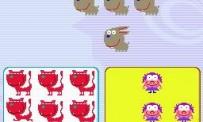 For mathematicians, Cérébrale Académie has three calculation tests. The first is to determine which game area has the highest amount of coins. The second will ask you to touch several cards so that their sum is equal to the total of items displayed on the double screen. The last test, like Dr. Kawashima's Brain Training Program: How old is your brain?, is presented as a mental calculation except that here everything is written in letters and that in some cases, instead to look up the result, you will need to find the denominator. This will bring back memories! We end this overview of Cerebral Academy training with identification. The simplest of the challenges is undoubtedly the Doubles where you have to find the pairs among the plethora of objects displayed. The exercise gets a bit more complicated with the shadows where you just have to touch the animal, the vehicle or the masked character. Of course, the forms move more or less rapidly and sometimes form an incomprehensible heap.
For mathematicians, Cérébrale Académie has three calculation tests. The first is to determine which game area has the highest amount of coins. The second will ask you to touch several cards so that their sum is equal to the total of items displayed on the double screen. The last test, like Dr. Kawashima's Brain Training Program: How old is your brain?, is presented as a mental calculation except that here everything is written in letters and that in some cases, instead to look up the result, you will need to find the denominator. This will bring back memories! We end this overview of Cerebral Academy training with identification. The simplest of the challenges is undoubtedly the Doubles where you have to find the pairs among the plethora of objects displayed. The exercise gets a bit more complicated with the shadows where you just have to touch the animal, the vehicle or the masked character. Of course, the forms move more or less rapidly and sometimes form an incomprehensible heap.
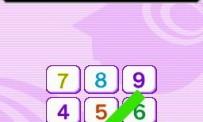 The ultimate game that will put your attention on alert is the Recomposition. Here too, a geometric shadow appears on the screen, but rather than foolishly touching its look-alike, you must replace other geometric shapes in such a way as to form the proposed set. "All this for what purpose?" you will tell me. Cérébrale Académie invites you to measure the weight of your brain through the "Test" mode which takes up a challenge from each workout. Speed and good answers will ensure you a good grade and for a little more fun, the ugly little teacher accompanying your tribulation will compare you to a famous personality or a very particular profession. Thus we learn that a film director outclasses Michelangelo and that Maxime is the reincarnation of Thomas Edison! Of course, you can compete with your friends thanks to the Multiplayer option of Cérébrale Académie, which is much more complete than the Dr. Kawashima's Brain Training Program: How old is your brain? Eight players can compete in different events with the possibility of gradually eliminating the little brains stupefied by Pokémon, Lorie, Star Ac', Mr. Pokora or SpongeBob. Enough to have a good time between two swims on the beach of Sion sur l'Océan, especially since Cérébrale Académie will not give you a bonus despite the bronze, silver, gold or platinum medals. Indeed, there is nothing to unlock as you succeed. Pity…
The ultimate game that will put your attention on alert is the Recomposition. Here too, a geometric shadow appears on the screen, but rather than foolishly touching its look-alike, you must replace other geometric shapes in such a way as to form the proposed set. "All this for what purpose?" you will tell me. Cérébrale Académie invites you to measure the weight of your brain through the "Test" mode which takes up a challenge from each workout. Speed and good answers will ensure you a good grade and for a little more fun, the ugly little teacher accompanying your tribulation will compare you to a famous personality or a very particular profession. Thus we learn that a film director outclasses Michelangelo and that Maxime is the reincarnation of Thomas Edison! Of course, you can compete with your friends thanks to the Multiplayer option of Cérébrale Académie, which is much more complete than the Dr. Kawashima's Brain Training Program: How old is your brain? Eight players can compete in different events with the possibility of gradually eliminating the little brains stupefied by Pokémon, Lorie, Star Ac', Mr. Pokora or SpongeBob. Enough to have a good time between two swims on the beach of Sion sur l'Océan, especially since Cérébrale Académie will not give you a bonus despite the bronze, silver, gold or platinum medals. Indeed, there is nothing to unlock as you succeed. Pity…
